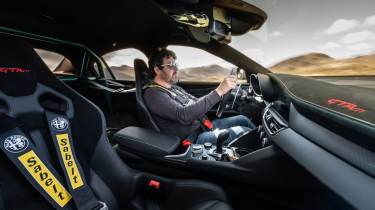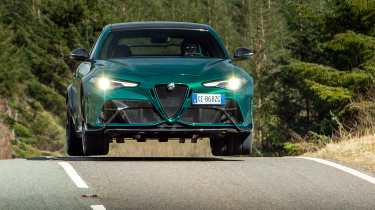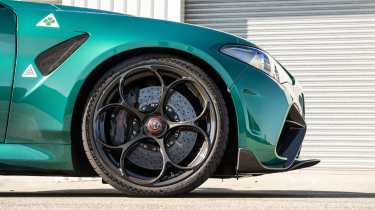Alfa Romeo Giulia GTAm (2021 - 2022) review: if Porsche built a four-door 911 GT3 RS
Alfa Romeo Giulia GTAm is the most extreme modern Alfa to date. It’s also one of its very best
I know what you’re thinking. It’s easy to be cynical about the Alfa Romeo Giulia GTAm. For starters, there’s the issue of slapping Alfa’s most evocative designation on a car that, though usefully lighter than the model on which it’s based, can hardly be described as truly alleggerita. You can also question the point of a four-door saloon with only two seats. Likewise the legitimacy of a near-£160,000 asking price.
Such dispassionate reasoning is water-tight, right up until a nice man from Alfa Romeo drives into view in what is currently the factory’s only GTAm, whereupon one longing look at the gorgeous, spangly green, carbon-clad device sees any argument against it crumble to dust. No doubt about it, this is one stunning machine.
> BMW M3 CS v Alfa Romeo Giulia GTA v Jaguar XE Project 8 – supersaloon specials go head-to-head
The backstory only adds to its desirability. Where the vast majority of manufacturers would have to justify such a project by using it as the pinnacle of some grand marketing plan in which the GTA name would be bastardised into some AMG-esque sub-brand, Alfa’s motive was far simpler: a 110th birthday gift to itself and a fabulous totem for the world’s Alfisti to worship. Better still, rather than build a one-off, Alfa committed to building 500 units, with the split between stripped-back GTAm and the full four-seat GTA decided by the market.
Technical highlights
Most of the changes over the Quadrifoglio are obvious. The wider body – made from a mix of carbonfibre and aluminium – gives the GTA a sensational physique. It’s also peppered with just-so detailing, most evocative of which is the Autodelta badge on each front wing. The aero kit is the work of Alfa Romeo’s F1 partner, Sauber. With adjustable front splitter and rear wing, plus a host of vanes and other detail elements to guide airflow beneath the car, it is both brilliantly OTT yet has a definite air of purpose about it.
More reviews
The wheels are 20-inch items, forged and attached via centre-lock hubs, a first for a saloon. Following Alfa’s classic teledial design, they look spectacular wrapped in 265/30 and 285/30 Pilot Cup 2s, with huge Brembo carbon-ceramic discs and brick-sized calipers showing from behind the spindly spokes. Steering and suspension systems have also been uprated, with wider tracks (by 25mm front, 50mm rear) and a dropped ride height on lightweight springs and controlled via re-rated electronic dampers.
The GTAm also features polycarbonate for the rear screen and rear side windows and replaces the rear seats with a bench (complete with crash helmet nets and a fire extinguisher), half-cage and full harnesses. Early news stories suggested the car would be 100kg lighter than the Quadrifoglio, but after some interrogation Alfa admitted the GTAm is in fact 40kg lighter, at 1580kg (the four-seat GTA being 1605kg). Partially stripping a road car’s interior only to add a roll-cage and extinguisher is the engineering equivalent of a dog chasing its tail, but for context the GTA’s spiritual rival, the Jaguar XE Project 8, weighs in at 1745kg.
Engine, transmission and 0-60 time
The GTA also has more power than the Quadrifoglio, with an increase of 30bhp to 533bhp (torque is unchanged at 442lb ft). The gain hasn’t been achieved with a quick ’n’ dirty remap, either. Rather Alfa has fitted new conrods and additional piston oil-jets. There’s also a new oil cooler and increased turbine speeds for the turbos. Fundamentally, though, the 2.9-litre V6 remains very close in character to that of the regular Giulia Quadrifoglio. That’s to say lusty, smooth and blessed with a deep voice and a pleasing rasp, thanks to the new centre-exit double-barrelled Akrapovic titanium exhaust system.
Everything about the GTAm looks and feels special. From the moment you open the driver’s door (which feels noticeably lighter) you know you’re readying to drive something very unique indeed. The carbon front seats are set very low and have fixed backs, meaning someone of modest stature (that’ll be me, then) looks like a kid driving their dad’s car. The driving position itself is spot-on, with plenty of adjustment in the steering wheel to get yourself set. Full harnesses look the part, but tend to be a massive ball-ache in a street car. Consequently I tend to rely on the regular inertia reel unless I know I’m going to be in the car for a while, but even I’ll admit that clipping the lugs into the lap buckle and pulling down on the shoulder straps is a ritual well-suited to the GTAm.
Pleasingly the GTAm manages to strike the very tricky balance between being an exotic high-performance special and a refined, civilised road car. Once you’ve settled into the seat it’s the same dab on the brake pedal and thumb of the red engine start button to fire the twin-turbo V6 into life as in a regular Giulia. The sound is a little more guttural, but the bass-rich tone and slight serration to the timbre is the GTA’s first hint at a sharper, more aggressive character. It makes you smile before you’ve moved even a metre.
Dynamic modes are selected by the ‘DNA’ rotary controller, which allows you to progressively ramp up or wind back the responsiveness of the powertrain and the firmness of the suspension, which in turn makes automatic adjustments to the intervention thresholds of the traction and stability control systems. There’s also Alfa’s equivalent of Ferrari’s ‘bumpy road’ button, which allows you to soften the damping back one stage from whichever main dynamic mode you’re in. So, for instance, if you’re in Race mode – which runs the suspension in its hardest setting as a default – one push of the button knocks it back to Medium.
What’s it like to drive?
Polished. That’s the word I’d use to describe the way the GTA makes progress. Everything feels just right, starting with the steering, which mixes modest weight with gin-like clarity and an assured but not exaggerated rate of response. The damping feels supple yet controlled, with enough pliancy to work with the road but enough control to keep those expensive underfloor aero vanes from grinding themselves away against unyielding granite chippings.
Where some cars have a superficially impressive veneer of capability, the GTA has true depth of dynamic quality. North Wales has a habit of quickly exposing weaknesses and limitations, but the GTA feels fabulous, agile on the tighter mountain roads and supremely accurate on the faster and more open sections. It’s one of those cars that seems to find an effortless flow.
Crucially it also feels light, with a willingness to change direction that makes every corner a source of pleasure. It’s at its best when carving through a series of bends, the way you roll from one lock to the other revealing terrific poise and a very special balance. There’s tons of grip, as you’d expect from such wide Pilot Cup 2 boots, but there’s progression and a kind of malleability that means you feel the car lean into itself without over-working the tyres or apparently building any inertia. Consequently, direction changes always feel smooth, with both ends of the car responding in harmony, and a precision that’s exceptional for a large car. You can genuinely turn in to a corner, sight your apex and rifle-shoot specific catseyes at will. It’s a wonderful feeling.
Another highlight is the brakes. The regular Giulia’s cast-iron discs have a slightly grabby feel to them on initial application, so I’d feared the GTA’s carbon-ceramic brakes might be more of the same, but instead they are beautifully progressive. Being easier to modulate means your approach to every corner is smoother, so the whole chain of inputs to brakes, steering and throttle is smooth and consistent.
Barrelling through the mountains against a backdrop of brilliant blue skies and breathtaking views is about as good a feeling as you can get, but the GTA is one of those cars that just makes the sensation feel that bit sweeter. With rock faces against which to reverberate, the V6 makes some rude and raucous noises, but there’s a hint of musicality that elevates it from the hard blare of, say, a BMW M4. It also delivers the odd gunshot report on upshifts that’s redolent of a GT3 race car. The nice thing is it doesn’t do it every time, so it’s always a treat.
Really extend it and a few chinks appear. The first is a slight lack of vertical control at the front end over crests, the nose lifting a little more than it should, then pecking a bit on the downstroke. It rarely requires you to moderate your speed, but it is at odds with the general sense of tight body control. The trait is exhibited to a greater extent by the regular Giulia (we brought our Fast Fleet Quadrifoglio along, too), so the engineers have clearly tried to address it in the GTA though with only partial success.
Given we’re talking about a 500-plus bhp rear-drive saloon, the way the GTA puts its power down is impressive. Yes, you need to watch your step on a cold morning as the Michelins are still asleep for the first few minutes, but the ESC is quick to catch any slips or slides. Once everything’s warmed up you can squeeze the throttle without fear.
> Alfa Romeo Giulia Veloce Fast Fleet test – 7000 miles in the sharp Italian saloon
There’s plenty of urge right through the rev range, with terrific low and mid-range shove that belies the V6’s modest displacement. One of the truly endearing things about the GTA (and indeed the Quadrifoglio) is that while the motor has the unmistakable muscle that comes with forced induction, it also has an appetite for revs and a real sense of building to a crescendo as the tacho needle sweeps towards the red line.
This breadth of performance and abundance of character means you’re fully connected to the machine. I’m somewhat ashamed to admit that often when driving a paddleshift car I let the gearbox decide when to shift, but I can honestly say when driving the GTA I did most of the gearshifts. It just feels like the right thing to do.
It’s fun, too, especially as the long-eared paddles mean you can take advantage of being able to brake, turn and downshift on the way into a corner. Likewise you can grab a cheeky upshift while powering out of a long corner and winding off the lock. I’m sure a manual version would have its own charm, but in this instance I don’t believe the lack of that option means we’re missing out on anything.
Perhaps surprisingly, there’s enough pliancy and composure to select Race mode on the road. This is where you experience the GTA in all its glory, with everything set to its most responsive setting. It also means you have no stability control system, which is admirably hardcore, but perhaps not for everyone. Truth is, on dry roads there’s ample grip and traction, so exploring the GTA’s performance is far from juggling chainsaws if you’re simply making rapid progress.
There is a caveat to this, but it’s only relevant if you’re intent on working beyond the GTA’s limits of traction and road holding. The issue is the behaviour of the electronic torque-vectoring limited-slip differential. It’s a trick piece of kit and doubtless assists in the car’s overall sense of agility, but the way in which it catches and redistributes torque lacks consistency and needs more progression. As it stands there’s an abrupt edginess to the way the GTA slips and grips that’s hard to read or balance.
What you want is an ability to initiate a slide with a slight excess of throttle, then to be able to ease out of the power just enough to slow the rate of breakaway. As you steer into the slide you can then apply more throttle, playing torque against traction and controlling the angle (we’re talking just enough attitude to feel the car come alive, not some reckless Fast & Furious-style drift-fest) with small adjustments of steering and throttle. What you get is a combination of needing to overcome strong limits of lateral grip and a diff that reacts sharply on and off throttle. The result is a spike of oversteer, which forces you to back out of the power and requires a quick snap of corrective lock to catch. As we’ll discover at Anglesey Circuit later, it’s easier to beast it with big yaw angles and wide throttle openings, but it’s actually the small nudges of road-appropriate oversteer that you can safely enjoy out of tighter corners and quiet roundabouts that are the ones that make a rear-drive car entertaining. As it stands, the GTA has immaculate poise and polish, but it would be pretty much perfect if it were just a little more playful.
Nevertheless, after two days on some of the best roads (and one of the most entertaining racetracks) the UK has to offer, it’s impossible not to feel smitten with the GTAm. It rides, stops and steers brilliantly, looks sensational, has dazzling detailing and a truly infectious character. Yes, it’s a ton of money (though possibly only for those of us who aren’t in its league) and yes it could be a little more accessible at its limits, yet I developed a deeper and more insistent desire for this faintly ridiculous yet utterly fabulous saloon car than I have for any number of today’s ‘harder-better-faster-stronger’ supercars. If you love cars, you’ll love the GTA.
Alfa Romeo Giulia GTAm: on track
Big four-door saloons don’t belong on track. There, I’ve said it. Hardly a contentious statement, but it still feels a bit mean-spirited when the GTAm goes to such efforts to seem at home in a pitlane.
It certainly looks the part, with those prominent Sauber-sculpted aero parts, the squat ride height, centre-lock rims and impressively athletic stance lending it the same purposeful look perfected by Ferrari with the 488 Pista or Porsche with any number of its GT 911s. The GTAm’s aura is ever-present, but a circuit environment definitely throws it into sharp relief.
With a helmet strapped on your bonce and the gently rising fizz of adrenaline flooding through your bloodstream, the silly seats and fiddly harness straps suddenly make more sense. The incongruity of being in a two-seat four-door with scaffolding and a fire extinguisher where the back seats should be remains strong, but with the focus of track driving comes a kind of sensory tunnel vision that centres on how the GTAm goes, stops, grips and gets through corners.
With a fresh set of boots on the 20-inch rims the GTAm has real bite once the compounds begin to wake up. The freeness, grip and precision that shine so brightly on the road feel amplified on smooth racetrack asphalt. Likewise the steering’s sweetly judged rate of response, which feels well aligned with the front end’s willingness to hunt out an apex. As on the road, it’s an intuitive car to guide as soon as you exit the pitlane.
Some of this comes from being able to work the Michelin Pilot Cup 2s harder and longer from the moment you make your steering input, but the adjustable aero kit also plays its part. We start with the front splitter at full extension with the rear wing remaining in its regular street setting (one up from low drag), then complete a second run of three timed fliers with the wing cranked into its most aggressive angle. The difference is tangible in terms of feel – and measurable against the clock.
In the former setting the nose feels nicely nailed unless you’re asking way too much from it, but the rear end is working harder to keep itself in check. Ultimately in this configuration you find yourself wanting a little bit more in the way of traction through the lower- and medium-speed corners, though it’s fine through the quick stuff.
Cranking more angle into the rear wing brings the desired increase in traction, but in finding more purchase it places greater demand on the front end, which now relinquishes its grasp first when you try and carry more speed. It’s not clumsy understeer – more a subtle shift from a neutral-to-oversteer balance to a neutral-to-understeer condition from turn-in to exit. It’s easier to make fine steering and throttle adjustments when you’re leaning on the front tyres rather than trying to balance traction and oversteer, so the lap is both quicker (by 3/10ths) and cleaner with this mild bit of push.
So, what was the lap time? 1min 16.3sec. For context, that’s 992 Carrera pace, so hardly hanging about, yet because the GTAm makes such an emphatic statement of intent and feels so good on the road, it’s impossible not to expect more – perhaps too much – from a 1580kg supersaloon. Not least because the only car that could be seen to be a direct rival for the GTAm – Jaguar’s equally loopy Project 8 – laps Anglesey’s Coastal Circuit a whole second quicker.
Then again, not only does the Jag have a 59bhp and 72lb ft advantage, but it also puts that potency into the tarmac through all four wheels – a combination that’s more than enough to offset its portly 1745kg kerb weight.
Subjectively the GTAm has many strengths and qualities that combined to make it not only very impressive but also entertaining, but there are one or two caveats. We’ve discussed the chassis, which is a real highlight, as are the brakes and gearbox – the former possessing a really satisfying blend of raw stopping power and precise, progressive response. On a dry track the ABS is almost entirely untroubled, even when you’ve very definitely outbraked yourself, and during our timed runs there was not a hint of fade – impressive given the nature of the Anglesey circuit.
The gearbox is equally undaunted by track work, snapping home upshifts and punching in downshifts without hesitation, and the long paddles are always within reach of a fingertip, so you can even grab a cheeky shift while fully committed on the way into or out of a corner.
The V6 has only been lightly breathed upon, so there’s little in the way of extra fireworks compared with a regular Giulia Quadrifoglio, though admittedly that is a quick car in its own right. It’s perhaps most accurate to say the engine – smooth, gutsy and sonorous though it is – is a strong supporting act, but not the main event. Once again, it’s worth remembering it displaces just 2.9 litres and has six cylinders, especially when recalling the raw grunt of the Project 8’s supercharged 5-litre V8.
Our only reservation once again centres upon the Giulia’s electronic torque- vectoring rear differential. A true torque-vectoring system and not one effected by independently braking individual rear wheels, it’s a proper piece of hardware, yet there’s a lack of consistency in the way it behaves in Race mode (which disables the stability control) and it also has a propensity for overheating when driven in extremis.
The inconsistency is actually the bigger issue, because it means the way the GTAm finds and maintains traction is tricky to read. Sometimes it digs deep for traction but then breaks it abruptly before trying to catch itself again. Other times – quite possibly the next corner – it slides more progressively.
The overheating issue only really becomes a problem if you’re repeatedly holding longer drifts, the diff wilting and eventually allowing the inside rear wheel to spin like a Catherine wheel. Admittedly, drifting is something you only tend to do when someone is pointing a camera at you and another person is paying for the tyres, but given that the vast majority of cars we test handle such treatment without throwing warning messages or needing a lie-down in a dark pit garage, it does suggest that Alfa’s diff is uncomfortably close to its operating limit.
It’s not a deal-breaker for this otherwise dazzling machine, but it is disappointing considering the rest of the car is so well resolved and its objectives are so rooted in absolute performance.
Price and rivals
£157,750 is an eye-wateringly expensive price to pay for a four-door saloon car where one that’s near identical and nearly as quick can be had for half the price. Or £157,750 is a bargain in a world of unobtainium that can cost ten times as much but offers a tenth of the rewards. Take your pick.
Jaguar’s XE Project 8 is off sale now but offers similar excitement and thrills, albeit in quite a different manner with its less feral supercharged V8 and less exuberant all-drive chassis. You could pick up a bewinged example for around £115,000. Or you could have spent £127,000 on a new 911 GT3, assuming Porsche will sell you one, that is.
Alfa Romeo Giulia GTAm specs
| Engine | V6, 2891cc, biturbo |
| Power | 533bhp @ 6500rpm |
| Torque | 442lb ft @ 2500-5500rpm |
| Weight | 1580kg |
| Power-to-weight | 343bhp/ton |
| 0-62mph | 3.6sec |
| Top speed | 186mph |
| Basic price | £157,700 |









